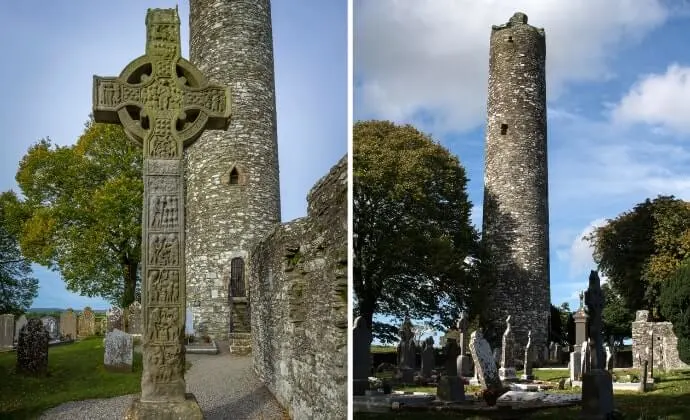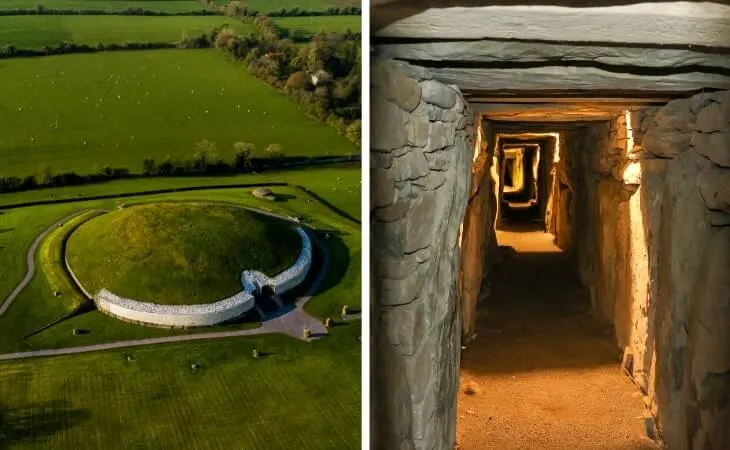A visit to the ancient Monasterboice is one of the more popular things to do in Louth.
Stand beneath the towering stonework, and marvel at the intricate carvings that date back to late in the first millennium.
You don’t have to be religious to enjoy a visit to Monasterboice, but you’re sure to be blown away by the beauty of the artwork and history.
Below, you’ll find info on everything from the history of Monasterboice and where to park to what to look out for when you arrive.
Some quick need-to-knows before you visit Monasterboice

Photos via Shutterstock
Although a visit to Monasterboice High Cross and Round Tower is fairly straightforward, there are a few need-to-knows that’ll make your visit that bit more enjoyable.
1. Location
Only a 10-minute drive northwest of Drogheda, the site of the High Crosses and Round Tower at Monasterboice is quick and easy to get to. It’s also the perfect addition to the brilliant Boyne Valley Drive.
2. Opening Hours
An ancient and historic site, it is open 24-hours a day, and accessible via a nearby car park. The site is best viewed during daylight hours; however, for photographers, it’s worth considering going earlier as the natural light against the High Crosses can be superb.
3. Parking
The car park across the street from the site (here on Google Maps) is able to accommodate 30-40 cars; Note, at times a height barrier is in place, so approach with caution as it can be hard to see. There is an overflow car park next to the toilet block, which apparently is motorhome-friendly.
4. Ireland’s finest high cross
It’s not hard to see why this high cross is considered to be the finest Celtic Cross in all of Ireland. At 5.5-meters high, and ornately carved its beauty is indisputable. The Cross of Muiredach, or South Cross, is the most stunning of the collection, and well worth the small amount of effort required for the visit.
5. A fascinating monastic site
As one of St. Patrick’s original followers, Saint Buite founded the site in the late 5th century, and the site has been an important religious centre ever since. The two churches and the graveyard have survived Viking invasions, the Cistercians abbey at Mellifont, and even the dissolution of the monasteries in the 1500s.
The history of Monasterboice High Crosses And Round Tower
Monasterboice, or Mainistir Bhuithe in Irish Gaelic, was the site of a monastic settlement that was founded in the late 5th century.
While the embers of St. Patrick’s Paschal fire still flickered in the memory of the Christian believers, Buithe, who was one of his original followers, put down roots for a new centre of religious worship at Mainistir.
History in abundance
Since then, the site has developed to house two 14th century churches, three High Crosses that date from the 10th century, and one remarkably preserved Round Tower that predates both the churches and the High Crosses!
Whilst the site’s religious practices were ceased back around 1142, the three ornate High Crosses have continued to draw visitors and pilgrims alike, as does the Round Tower that offered earlier settlements an ability to spot potential danger in the distance, as well as protection from possible attack.
Later years
Sadly, access to the inside of the tower is no longer possible due to fire damage from 1097/98 when the monastery was badly damaged.
The site fell into ruin after all religious observances were transferred to nearby Mellifont Abbey, with only a small parochial church using the site until the 13th century. Little is known after this point, yet the High Crosses and Round Tower have remained as silent sentinels through the ages.
What to see at Monasterboice

Photos via Shutterstock
One of the reasons that a visit to Monasterboice is so popular is due to the sheer volume of things there are to see here.
Below, you’ll find info on everything from the Monasterboice High Crosses (Muiredach’s High Cross) to the beautiful Round Tower.
1. The Monasterboice High Crosses

Photos via Shutterstock
Without a doubt, the famous Muiredach’s High Cross, or South Cross as it’s also known, rightly deserves its title as the Finest High Cross in Ireland. At a staggering 5.5-meters high, and carved from solid stone, it is suggested that the cross is Ireland’s greatest contribution to European sculpture, and has earned a nomination for UNESCO recognition.
Each of the four carved faces depicts different biblical scenes, including those of The Last Judgement, and the Crucifixion of Christ, the Adoration of the Magi, Moses drawing water from the rock, and David and Goliath to name but a few.
There are concerns regarding the continued preservation of the cross, as some damage has been detected due to weathering, and acid rain as a result of the nearby M1.
2. The Round Tower

Photos via Shutterstock
Round towers were frequently used in the first millennium across Ireland as both watchtowers and protective defences against invaders or violent attacks against monks. They were usually found on or next to churches, as they were also used as a bell tower or belfry to call followers to worship, or to herald in ecclesiastic events.
The Round Tower of Monasterboice is a remarkable example of these structures, as much of the tower is intact despite extensive fire damage from around 1098. You can still see the main door – nearly at ground level now – which was usually set at between 2 and 3 meters above ground, the stone ‘cap’ roof in its conical shape, and the cardinal windows at the top.
3. Other notable features
As you’d expect with a site this large and old, there’s a bit more to see and discover. Wander through the historic graveyard and see if you can find the oldest gravesite – there are loads that date back over many centuries, and some newer ones as the burial site is still being used.
If you do stroll through the quiet and peaceful surroundings, you might also discover the sundial, which you can always check the time against and test its accuracy. The ruins of the two 14th-century churches are also worth exploring, especially if you’re into photography.
There are some stunning shots possible, particularly in the afternoon light, and the pre-arranged guided tours of the monastic site are highly recommended.
Things to do near Monasterboice
Monasterboice is a short spin aways from many of the best places to visit in Meath and Louth, as it happens.
Below, you’ll find everywhere from more ancient sites and bustling medieval towns to one of the finest beaches in Louth.
1. Mellifont Abbey (10-minute drive)

Photos via Shutterstock
Founded in 1142, Mellifont Abbey’s name accurately describes why it was founded; An Mhainistir Mhór or Big Monastery, as it was replaced nearby Monasterboice’s settlement on the orders of St. Malachy. Take the quick 10-minute drive to see the larger sister-church, and see where the Treaty of Mellifont was signed in 1603.
2. Drogheda (10-minute drive)

Photos via Shutterstock
Although usually regarded as an industrial and port town, there are several things to do in Drogheda that should not be missed. Magdalene Tower, Millmount Museum and Laurence’s Gate are all worth a look. There’s plenty of great pubs in Drogheda, too!
3. Brú na Bóinne (16-minute drive)

Photos via Shutterstock
Pre-dating Stonehenge, the 780-hectare burial site at Brú na Bóinne is truly palatial and beyond historic. With Neolithic passage tombs, cave drawings, rock art, and another 90 monuments, it’s worthy of its World Heritage listing. Visit to see Newgrange, Knowth and Dowth.
4. Clogherhead Beach (18-minute drive)

Photos via Shutterstock
Clogherhead Beach is another excellent spot for a stroll. However, if you’d like to dodge the sand, the gorgeous Clogherhead Cliff Walk is well worth doing. Just make sure to park in the car park near the Harbour.
FAQs about visiting Monasterboice
We’ve had a lot of questions over the years asking about everything from ‘Who founded the monastery in Monasterboice?’ (St Buite) to ‘Which County is Monasterboice in?’ (County Louth).
In the section below, we’ve popped in the most FAQs that we’ve received. If you have a question that we haven’t tackled, ask away in the comments section below.
What can you find in Monasterboice?
The main attractions at Monasterboice are the high crosses and the round tower. There’s also several other notable features worth admiring (see above).
Is Monasterboice really worth visiting?
Yes! This is a fine example of ancient Ireland and the high crosses and the round tower are well worth checking out.
